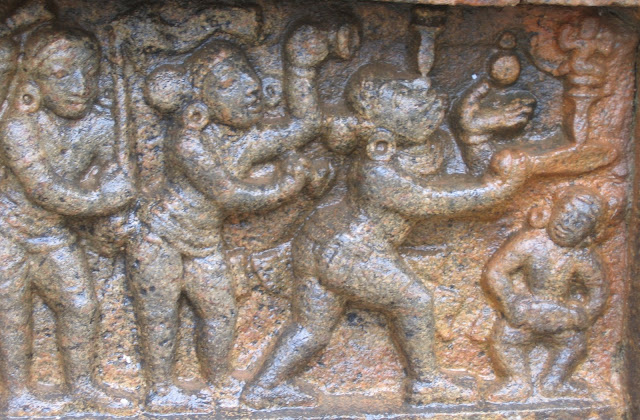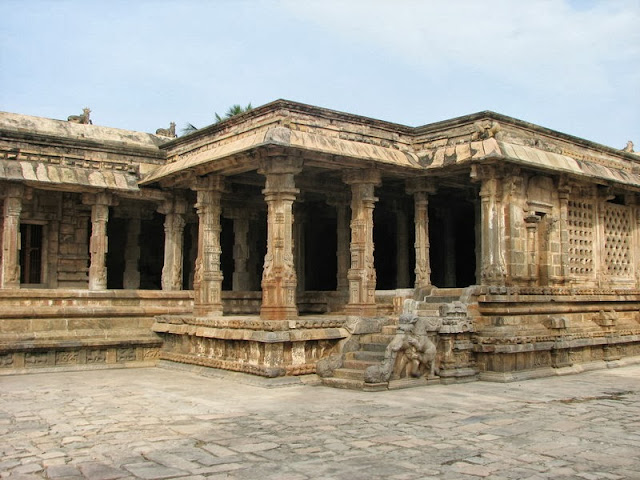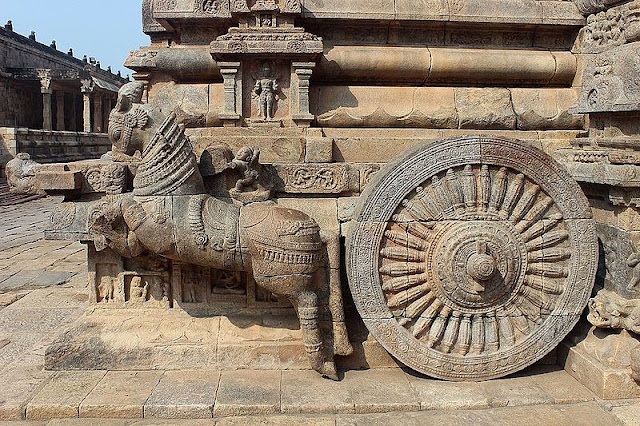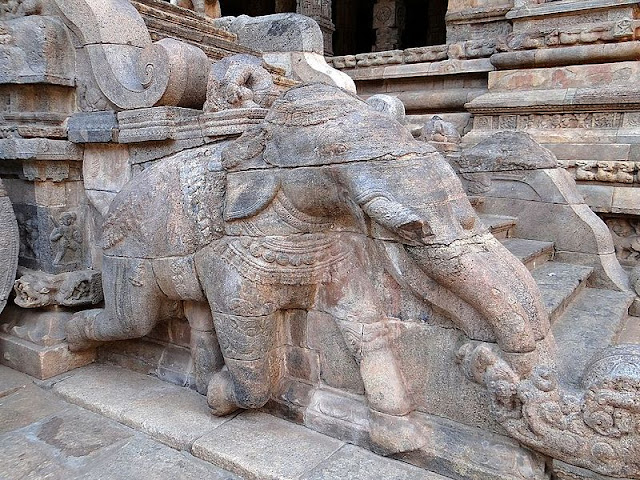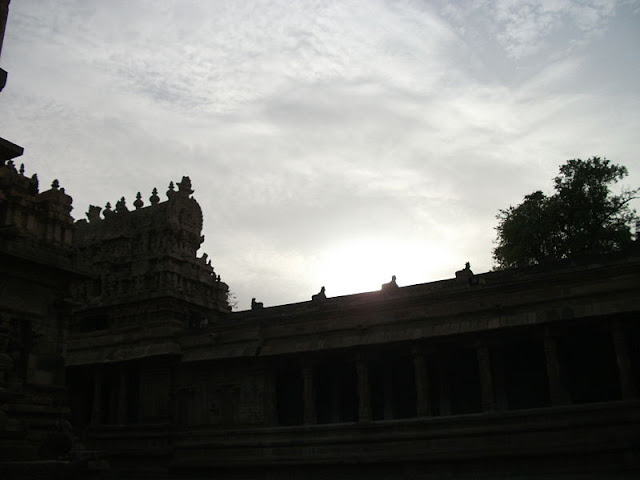Airavatesvara Temple, Darasuram – Architecture
Darasuram is located in the Palaiyarai region, which
remained an important centre of Chola administration even when new capitals
such as Thanjavur and Gangaikondacholapuram were established. Darasuram became a
temple settlement of great importance, centered on a Siva shrine built by
Rajaraja II in the twelfth century. This is the third in line of the grand
stone vimanas built by the imperial Cholas, and its compound wall measures 105
m east-west and 67 m north-south. The vimana is about 24 m high, with five
diminishing tiers. Above the fifth tier rests the circular griva with niches at
the cardinal points flanked by outfacing Nandis at the corners, and surmounted
by a dome, the sikhara and metal stupi.
This temple is a storehouse of art
and architecture and has some exquisite stone carvings. Although this
temple is much smaller than the Brihadeeswarar Temple or the Gangaikondacholapuram Temple, it is more exquisite in detail. This is because this
temple is said to have been built with nitya-vinoda, "perpetual
entertainment", in mind.
The temple starts with a mahadwara, main entrance on the
eastern side. The vimana (tower) is 24 m (80 ft) high. The
temple consists of a sanctum without a circumambulatory path and axial
mandapas. The front mandapa is known as Rajagambhiran tirumandapam in the inscriptions. The south side of the front mandapam is in the form of a huge chariot with large stone
wheels drawn by horses. The pillars of this mandapa are highly ornate. The
elevation of all the units is elegant with sculptures dominating the
architecture.
To the east of the inner court lies a group of
well-carved buildings, one of which is the Balipita ('seat for
sacrifice'). The pedestal of the Balipita adjoins a small shrine
which contains an image of Ganesha. The pedestal has a set of 3 finely
carved set of steps on the south side. Striking the steps produce different
musical sounds (seven basic notes of music).
In the south-west corner of the court is
a mandapam having 4 shrines. One of these has an image of Yama.
Adjoining this shrine are large stone slabs sculptured with images of the Sapthamadhas (seven
celestial nymphs). The construction of a separate temple for Devi,
slightly later than the main temple, indicates the emergence of the Amman
shrine as an essential component of the South Indian temple complex.
The main mantapa is called Raja Gambira as the elephant
draws the chariot. The wheels were put back by the ASI at a later date. The
ceiling has a beautiful carving of Shiva and Parvathi inside an open lotus. All
the dancing poses of Bharatnatyam are carved in the stone. They are referred to
as the Sodasa Upasaras. There is a carving showing the village womenfolk
helping in the delivery of another female, who has both her hands on the
shoulders of the two ladies, who are pressing their hands and the abdomen of
the lady to help her deliver. 'These are very skillful and artistic works of
superb style. This may give a glimpse into the social conditions of the past.
The stone image of Ravana carrying Kailas is a fine specimen of workmanship.
One finds sculptures of Buddha, Bhikshatana, Saraswathi without her Veena, and a sculpture of Ardhanarishvara, Brahma and Surya.
It was during this time that Shaivism took a very
drastic step and lord Sarabeswarar would seem to have come into existence. Many
reasons have been cited for this incarnation of Lord Shiva. Sarabha has the
face of a lion and the body of a bird and has placed on his lap the mighty Lord
Narasimha. A mantapa has been specially built for lord Sarabha, and thereafter
has been installed in temples. The paintings on the walls have been repainted
during the Nayak periods.
At the very entrance to the temple two Dwarapalakas,
Sankhanidhi and Padmanidhi are imposing figures, giving vivid anatomical
expressions of the exuberance of youth. In front of the temple, there is a
small mandapa, which can be reached by three steps in the form of a ladder. The
steps are stones, which give different musical sounds when tapped. All the
seven swaras can be had at different points. It is feared that if proper care
is not taken soon, village children will damage the stones. Now these stone
steps have been completely covered with metal grills to save them from
deterioration. Meanwhile Archeology department has taken many steps to prevent
this monument from public viewers and local villagers.
As one enters the Airavatesvara temple, one finds a
large gopura. Its upper portion is completely lost, but its original form may
be able to be gauged from the fully preserved gopura inside. The larger prakara
wall all around the temple, decorated at intervals with couchant bulls, is a
continuation of this second gopura. Pillars in a row support the gopura, and
these are decorated with some fine carvings of lovely apsaras, Siva-ganas and
other motifs. Beyond the gopura is a large bali-pitha with beautiful lotus
petal decorations.
To one side of it, just behind the large Nandi, is a
quaint, standing dwarf Siva-gana blowing on conch. Both the Nandi and the
Sivagalla are fine artistic creations. Long narrow strips of frieze adorned
with a series of miniature figures dancing in lovely poses to musical
accompaniment, provide the key-note of this temple's decoration: nitya-vinoda, perpetual entertainment. On
either side of the entrance are small balustrades, intended to flank steps (now
missing), with beautiful makara-decorations on their exteriors. Each makara has
a floriated tail, short legs and curled-up snout, with a pair of dwarf
gana-riders, and the series forms a lovely motif.
At the entrance there is a beautiful mandapa with a
number of pillars approached through an extension towards the south, and
equipped with flights of steps to the east and west. The exteriors of the
balustrades for these steps are exquisitely decorated with a long curling trunk
coming out of a lion-head; and a similar design running parallel to the trunk
of an elephant, lost in the open jaws of a makara whose floriated tail is
curled up, to balance the complete design. The elephant is beautifully
decorated and mounted by dwarf ganas, viz. the sankha- and padma-nidhis.
The mandapa's eight outer pillars are supported by
squatting yalis with their trunks curled up and pronounced abaci; while the
lotus-petal decorations below have prominent petal-tips. The pillar capitals,
like other pillars in the mandapa, show the beginnings of the bodhika-decoration,
which, in late Chola and Vijayanagara periods, develops into the
lotus-decoration. Each of the four inner pillars is divided into sections,
three oblong and two polygonal. The decoration, which later develops into the naga-bandha,
is just discernable and, as in other early Chola structures, consists of a
pattern of double-geese. The rectangular portions of the pillars are decorated
with small panels illustrating mythological stories such as the attack of
Manmatha, the penance of Parvati, the prayer of the gods for a son of Siva, the
birth of Kumara, Siva's marriage, his fight with the asuras and more. On four
pillars that lead to the extension of the mandapa there are short and repeated
inscriptions describing it as Svasti Sri Rajagambhiran tirumandapam.
If the elephants on the sides of the balustrades of the
steps mentioned above are lovely carvings, there are equally impressive
galloping horses, one on either side, of the mandapa-extension, immediately
beside the flight of steps. Also known as the Raja-gambhiram tiru-mandapam
after Rajaraja II, this agra-mandapa is conceived as the chariot of
Tripurantaka - with wheels, hubs and spokes carved in relief, drawn by
caparisoned horses.
The form has precedence in a temple near
Gangaikondacholapuram as well as two shrines in Chidambaram and Tukkachchi. It
is also interesting that over a hundred years after the completion of
Darasuram, it was a distant descendent of the Chola emperor Kulottunga I who
built the Konarak temple with its giant chariot mandapa in Orissa. A chariot
shaped mandapa also exists in Hampi, Vijayanagara.
The base of the mandapa-extension is decorated in front
with panels of: Siva fighting the Tripuras from his chariot, and Siva as
Kalantaka fighting Yama to protect the son of Mrikandu, whom he had blessed
with a long life; Siva burning Kama, who dared attack Siva with his flowery bow
and arrow, as Kama's lovely queens, including Rati, and other gods pray for his
life; and the destruction of Daksha's sacrifice by Virabhadra. Above this, at
intervals in five niches, are Agni, Indra, Brahma, Vishnu and Vayu, all were standing
with hands in the attitude of reverence towards Siva. It should be noted that
the original plan of the steps east of the mandapa has been spoilt by later
renovations, and their original symmetry is now lost.
The main mandapa is a continuation of the mukhamandapa of
the main shrine. The outer faces of its walls on the northern side and on the
extreme ends of the eastern and southern sides, as in other parts of the
temple, are covered with the usual pattern of niches and pilasters. The outer
walls of the second mandapa are entirely closed and all its pillars are inside.
Here too the outer walls are decorated with a pattern of alternating niches and
pilasters, with a main niche for every pair of subsidiary niches. The main
mandapa is decorated to the east with a pair of dwarf yakshas guarding padma-
and sankha-nidhis in niches on either side. These figures, like all the other
special forms of deities in the niches, are made of fine-grained black basalt,
thus distinguished from the lighter coloured granite used in the rest of the
structure.
The pillars of the first (main) mandapa have beautiful
patterns of decorative creepers so arranged that the circular medallions
created contain figures dancing in diverse poses, musicians and sometimes even forms
of deities such as Gangadhara and Tripurantaka. These figures also adorn panels
arranged in tiers of niches and salas on the sides of other pillars. Even where
the pillars have purely decorative patterns, such figures, mostly in
dance-poses or playing musical instruments, are deftly introduced into them. The
ceiling has square and rectangular patterns, bands of which are all filled with
decorative designs. Almost all the central medallions contain similar dancing
and musical groups. The pillar-capitals here bear the precursors of the
bodhika-type, and the ornamental precursors of the naga-bandha are also
visible.
In the next mandapa, which leads to the ardha-mandapa
and the main shrine, there are niches containing Devi with lotus, ratna-kalasa
(pot filled with gems) and Nandikesvara standing with hands in adoration on one
side, and saint Kannappa and seated Sarasvati on the other. The centre of the
northern side has been improvised into a cell for Devi. The chauri-holding
dvara-palikas, fixed on either side of the improvised doorway, are lovely and
belong to the same period as the other fine sculptures arranged in the niches
of the main temple. The pillars in the mandapa adjoining the main one are
somewhat simpler, notwithstanding their polygonal shape, the flower-petal
decorations at intervals and the corbels, which recall the Chalukya type.
The mukha-mandapa is approached by long flights of steps
from the north and south, and marks the end of the mandapas and the beginning
of the main shrine. Here there is a couchant Nandi, smaller than the one at the
start of the main mandapa. The dvarapalas of the main shrine are depicted as
furious and armed with huge clubs. Their four hands are in the threatening
attitude (tarjani), they have tusks and carry trisulas on their bound-up hair, which
is decorated with the lion-head design. The garland-decoration of their
yajnopavita also recalls Chalukya influence.
The six-headed Kumara standing to the left of the main
cell's entrance is a fine sculpture. The walls of the mandapa and main shrine contain
niches, some of which still have exquisite specimens of early Chola sculpture; the
others either have no images or poor modern substitutes in brick-and-plaster. Noteworthy
Chola specimens include: a fine Ardhanarisvara, unique among its kind with three
faces and eight arms; a four-armed Nagaraja with snake-hoods over his head and
hands joined in adoration; Agastya, the dwarf sage, seated with one of his
hands in the teaching attitude and the other carrying a water vessel; another
seated sage carrying a rosary and manuscript; dancing Martanda-Bhairava or
Aghora-Virabhadra with four hands, three heads and a terrible countenance;
standing Ganesa; Dhakshina-murti attended by sages seated under a banyan-tree
and expounding the highest truth; Lingodbhava Siva, issuing from a flaming
pillar, while Brahma and Vishnu, unable to reach the top and bottom, adore the
linga; Brahma; eight-armed Durga on the severed head of the buffalo-demon;
seated Devi as Bhuvanesvari carrying pasa and ankusa in two hands, the other
two being in abhaya and varada; Siva as Tripurantaka, carrying the axe, deer,
bow and arrow; multi-armed Gajantaka destroying a demon in the guise of an
elephant and dancing against the spread-out hide of the animal in the
bhujanga-trasita pose while Devi shrinks away from him in fear; Bhairava with
six arms standing with his dog behind him; a sage carrying a water-vessel and
teaching two disciples; and Mahesamurti seated with three heads and four arms
carrying the spear, axe, rosary and water-vessel. All these sculptures, made of
polished black basalt, display exquisite workmanship.
Of particular interest among these, in a shrine attached
to the southern wall of the mandapa, is a stone image of Siva as Sarabhamurti. The
Sarabha cult represents a phase in which Saivism dominated Vaishnavism,
symbolized by Sarabhesvara subduing the ferocious Narasimha, an incarnation of
Vishnu.
Of the sides of the main shrine it should be said that
the lower half of the base is of the same type all over, including the
mandapas. The lowest series of panels above the lotus-petal decoration ·is
divided by decorative bands which contain yalis, couchant or rearing, in pairs
or single; women dancing to music; dwarf ganas in varied poses, dancing, playing
drums, blowing conchs, carrying the chauri or holding their hands in wonder,
often in the company of a bull. Above this is a long yali frieze, which is
repeated a little below the niches. There are miniature decorative carvings a
little below the second row of yalis, above it, and immediately below the
niches. In the main shrine the carvings below the niches depict stories of
Saivite saints, some of which are labeled in Tamil. Separating these scenes are
miniature carvings of dancing figures, and Siva or Devi in different attitudes.
On the outer walls, on either side of the niches, there
are fine carved figures corresponding to those enshrined in the niches,
simulating the tradition of the earlier temples at Thanjavur and
Gangaikondacholapuram. Thus, Ganesa's niche is flanked by Bhutaganas, dwarf
attendants, carrying offerings with the deity's vehicle, the mouse; the niche
of Dhakshina-murti is flanked by exquisitely carved figures of rishis which
are, unfortunately, hidden by a later brick structure.
There are three niches in the main temple. The Central
one is the largest and has a double-pillar decoration on either side. Its top
is fashioned as a sala, while the tops of the niches flanking it have the
Koshtha-pattern. The double- pillar decorations between these have lion-headed kudus
on top. Between the niches and the double-pillar decorations, all of which
project forward, there are kumbha-panjara decorations against the main wall
itself. Above the niches, near the eaves, there is a whole row of dwarf ganas,
dancing, playing musical instruments or otherwise merry. Against the roof,
there are kudus, while gaping bhuta-heads serve as gargoyles, discharging water
from the roof. The kudu-pavilion and sala-patterns are repeated on the tiers of
the vimana.
All around the main shrine is a broad strip, 3.66 m
wide, paved with granite slabs, and a low wall, 25.40 cm high, of the same material.
The latter is beautifully carved with lotus-patterns and Nandi is seated in between;
but, unfortunately, this beautiful row of Nandi is badly mutilated. The outlets
for water placed at intervals reveals that this was intended to be a sort of a
pleasant water-receptacle, which would give the idea of a pool surrounding the
temple in spring and keep the atmosphere cool in summer. A number of circular
rings with low rims, carved out of stone, appear to have been lamps.
The gargoyle that discharges water from the main cell is
on the north. It is long, has a dip and double course, is decorated with two
lion-head motifs, one at the source and the other where it starts the lower
course at the point of the dip, and discharges water into a large well-carved
water-reservoir with figures of dancing ganas on the sides. The gomukha is
supported at the base by a caryatid dwarf gana, as in the gargoyle in the
temple at Thanjavur (though the figure here is standing), by a rearing yali and
triple ganas at the end. Close to the main temple, near this gargoyle, is the
shrine of Chandikesvara, similar to the one at Thanjavur.
The prakara-wall surrounding the large paved courtyard
is carved on the inside with a beautiful series of mandapa-decorations, which
consist mainly of a long row of pillar-cloisters, with cells at intervals for
deities, some of which have disappeared. At the four corners the cloisters are enlarged
and embellished into mandapas. These mandapas are approached by steps decorated
with balustrades, with interesting motifs. For instance, there is a ferocious
lion pouncing on an elephant with a curled-up trunk, lost in the mouth of a
makara, its sides hidden at those points where a niche or trellis-window has
been added for decoration. The base, as usual, has fine panels showing scenes
of dance, jugglery, and so on. All these elements are best seen in the
north-west mandapa. Towards the north-west there is a similar mandapa, with intricately
decorated pillars; and the ceiling is covered with a profusion of beautiful
panels and medallions of dancers and musicians.
The top of this mandapa is decorated with a sala-roof
suggesting Nataraja's sabha. This is the temple's natya-mandapa - a fact
clearly borne out not only by the sculptures on the pillars and ceiling but
also by a carving on the base of Vishnu playing the drum before the mandapa.
Now conserved, this must have been where the Nataraja bronze was originally
housed. Beyond this, to the east, is the yaga-sala, and further on is a
representation of a king and queen, in addition to figures of deities.
The two portrait-statues are probably intended to
represent either Virarajendra or Rajaraja II, and his queen. In the cloistered
hall to the west of the natya-mandapa there is a remarkable group of large carving,
representing Siva as Kankala-murti, and a number of rishi-patnis - the wives of
the sages of Daruka-vana, who attended on Siva and were astonished by his
beauty. The garments of one of the women in a pair are slipping off and the
other has a finger on her lips, indicative of wonder while gana-dwarfs are
playing drums or sounding gongs in quaint and picturesque attitudes.
Kankalamurti himself is calm and serene, as he fondles a
deer with one of his hands, while a dwarf-attendant carries his begging bowl.
Some of the women carry ladles for offering food to the divine beggar. The
composition is one of the great masterpieces of Chola art. There are also
carvings of Manmatha and Rati on a chariot, and of Kannappa-nayanar, the
saintly hunter.
On the western half of the southern prakara-wall are
represented one hundred and eight Sivacharyas (Saiva saints), with the names
and short descriptions of each incised below them. They were probably appointed
to sing Devaram hymns in the temple.
In the roofs of the niches, all along the wall of the
mandapa to the north, there are representations of rishis. These, along with
similar figures within the niches, indicate an element of peace and tranquility,
as opposed to the heroic quality which marks the sculpture at Thanjavur and Gangaikondacholapuram.
The long series of stories from the Siva Purana and the
Siva devotees portrayed here also suggest the same theme. It should be noted
that this was the period when stories of Saiva kings and the sacred Devaram hymns
were collected together. It is also not unlikely that the name Darasuram has
something to do with Daruka-vana, especially considering the magnificent group of
sculptures representing Kankala and the rishi patnis described above.
The temple's linga is called Raja Rajesvaram-udayar and
it is said that the temple was erected by Rajaraja himself to please a cowherdess
who had donated the huge sikhara stone at Thanjavur, and subsequently desired
that a temple be constructed in her village.
There are also similarities with the artistic traditions
of Borobudur and Prambanan in Indonesia here, particularly in the scenes that
narrate stories of the Saiva saints, with depictions of temples, ponds or
rivers full of fish, shells and other aquatic animals (in one case even a crocodile),
along with several figures of kings with royal paraphernalia, such as
peacock-feather parasols, sages and Brahmanas with umbrellas in their hands,
and similar themes.
In fact, even the lions in the lowermost panels of the
base of the main shrine are strongly reminiscent of their counterparts at
Prambanan. It is not surprising since there was considerable intercourse
between the Eastern Archipelago and India during the Chola period, most of
these islands having been under Chola rule for some period of time.
Rashtrakuta and Chalukya styles are recalled by certain
decorative elements, particularly the creeper-patterns that create medallions
for dance-figures on the pillars and some pillar-capitals. This is easily
accounted for by the constant inroads that the Cholas, Rashtrakutas and
Chalukyas made into each others' territories.
On the Southern side of the temple, one finds a line of
lamp posts on the ground. Lamps were believed to have been placed on top every
evening. Alongside the stretch of lamp posts are sculptures of Nandi, whose
heads have been knocked off.
While the base of the temple was built by the Chozhas,
as can be seen from the granite construction, the top portion/structure was
renovated by the Nayak Kings as can be seen from the mixture of the
construction materials used- Gun Powder and Red Bricks.
The main Eastern entrance to the temple remains a Mottai
Gopuram (no tower). Interestingly and not to be seen elsewhere, the Amman
Sannidhi is in a separate temple just next to and North of the Airavatesvara
temple.
In sum: though the temples at Thanjavur and
Gangaikondacholapuram were simple in design and grand in stature, their
maha-mandapas appeared to be there only to satisfy the Agama requirements and
the practical needs of managing the temples and state affairs conducted in
them. A century later, the Melaikkadambur temple was designed purely as a
chariot; and the great advancement that the Darasuram temple makes over its
illustrious predecessors is to integrate the two styles. Stylistically, the
Airavatesvara temple marks the transition from the full plenitude of the Chola
style seen at Thanjavur and Gangaikondacholapuram - to the great temple
complexes of the post-Chola era.







































